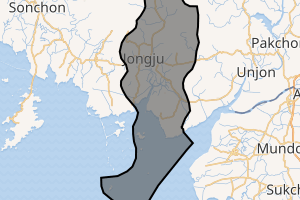Chongju
Chŏngju (Korean pronunciation: [tsʌŋ.dzu]; also Jŏngju) is a si, or city, in southern North P'yŏngan province, North Korea. Prior to 1994, it was designated as a kun or county. The terrain is mostly level, but mountainous in the north. To the south lies the Chŏngju Plain, where the hills do not rise above 200 metres (660 ft). Chŏngju also includes approximately 10 islands in the Yellow Sea.
Chŏngju 정주시 | |
|---|---|
| Korean transcription(s) | |
| • Chosŏn'gŭl | 정주시 |
| • Hancha | 定州市 |
| • McCune-Reischauer | Chŏngju-si |
| • Revised Romanization | Jeongju-si |
Chŏngju Station | |
Map of North Pyongan showing the location of Chŏngju | |

| |
 Chŏngju Location within North Korea | |
| Coordinates: 39°39′N 125°20′E | |
| Country | North Korea |
| Province | North P'yŏngan |
| Administrative divisions | 14 tong, 18 ri |
| Population (2008) | |
| • Total | 189,742 |
| • Dialect | P'yŏngan |
| Time zone | UTC+9 (Pyongyang Time) |
Geography
Some 40 percent of Chŏngju is covered by coniferous forestland.
Administrative divisions
Chŏngju is divided into 14 tong (neighbourhoods) and 18 ri (villages):
|
|
Economy
Local agriculture is dominated by orcharding and rice farming; the chestnuts of this region are especially famous.
Transportation
The city is served by both road and rail; it is the junction point of the P'yŏngŭi and P'yŏngbuk lines of the Korean State Railway.
Politics
In February 2011, the city and others in North P'yŏngan had rare protests, of a few score of people, calling for adequate provision of rice and power. At the time, news of the Arab Spring was spreading via Chinese TV channels and phone calls with defectors.[1]
See also
References
- Can the 'Jasmine Revolution' Spread to N.Korea?, Chosun Ilbo, 23 February 2011
Further reading
- Dormels, Rainer. North Korea's Cities: Industrial facilities, internal structures and typification. Jimoondang, 2014. ISBN 978-89-6297-167-5
External links
| Wikimedia Commons has media related to Jongju. |
- (in Korean) In Korean language online encyclopedias:
- City profile of Jongju
